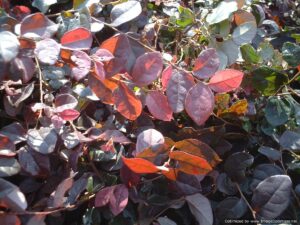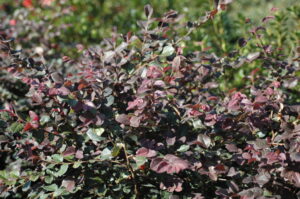S & J Nursery’s guide to Growing
Ruby Loropetalum
Chinese Fringe Flower
(Loropetalum chinensis var. rubrum )
*This page is being kept for informational purposes only as we are not currently growing this Loropetalum selection*
Loropetalum ( Chinese Fringe Flower )  Origins:
Origins:
-Loropetalums are native to Japan and Southeast Asia and brought into cultivation in the United States in 1880. They have since the introduction of purple flowering varieties in 1990 quickly become a North Florida garden favorite for both foliage and flower color in the landscape. There are many varieties to choose from each with their own mature size ( some as small as 3 ft and others reaching 12-15 ft full grown), form, flower color ( ranging from white to shades of pink and even deep dark burgundy red), Loropetalums even vary in leaf color and shape.
Loropetalum Ruby Preferred Exposure:
-Loropetalum Ruby will prefer a full sun to partial sun with at least 6 hours of good direct light in the North Florida | Jacksonville | St. Augustine areas gardens. Although some green leaf Loropetalum varieties will tolerate a fair amount of shade the purple leaf varieties will tend to loose color and fullness when planted in areas without adequate sunlight.
Loropetalum Ruby Foliage:
-Evergreen foliage of the Loropetalum Ruby shrub has deep reddish purple colored new growth that matures to a green as it ages.
Loropetalum Ruby Soil Preference / Salt tolerance:
– Loropetalum plants prefer rich moist but well drained slightly acid soils.
Ruby Loropetalum will have a tendency towards chlorosis in soils with a high PH.
-Salt tolerance low to medium
Loropetalum Ruby Size Variance:
– Loropetalum Ruby can reach sizes of 5-6+ feet High | 4-6+ feet Wide
Loropetalum Ruby Growth Habit:
– Loropetalums grow quickly and have an open slightly arching branch habit. Prune these shrubs into a rounded mushroom form to work with the plants natural shape and habit.
– Although they can be maintained into a more formal squared hedge it is not recommended as it requires frequently prunings that tend to expose bare branches on the sides of the shrub when attempting to turn them into a more formal narrow boxed hedge row. If you prefer them this way remember to taper the top of the shrub to be narrower than the bottom to allow adequate light to reach the lower branches.
Loropetalum Ruby Growth Rate:
– Fast growing shrub quickly establishes itself into the landscape. Make sure when planting Loropetalums to give them some room, planting to closely only makes pruning a frequent chore that didn’t have to be, give them room to spread vertically and you will be much happier with them once they have reached your desired height.
Loropetalum Ruby Bloom:
– Loropetalum gets it common name Chinese Fringe Flower and its Latin name Loropetalum from it delicate strap like blooms. If your familiar with the blooms of the Northern plant Witch Hazel, a relative of Loropetalum then you know the bloom of Loropetalum plants. The tiny clusters of strap like petals absolutely cover the plant in the spring and they bloom intermittently throughout the summer and again pretty heavily in the fall and winter months here in the North Florida landscape.
– Loropetalum Ruby has fringe-like blooms are a ruby red color.
Loropetalum Ruby Water Requirements:
– Loropetalums is drought tolerant once established into the landscape but requires attention to daily watering when first being planted from the nursery containers into the landscape, especially during North Florida | Jacksonville | St. Augustine area’s hot summer months.
– CAUTION: Loropetalum plants don’t easily forgive you and perk back up once you’ve allowed them to dry out like so many other hardy shrubs, the leaves will turn a tan color and almost crumble to the touch, recovery may or may not happen depending on how long the newly planted Loropetalum stayed dried out before you noticed it. A little tender loving care in the beginning will give you countless years of maintenance free beauty so they are well worth the extra TLC after planting time. To make sure your Loropetalum plant is rooted in and able to survive on its own, keep watering well until you have seen active new growth forming and
flourishing on your plant. Then taper the water back a little at a time.
Butterfly or Bird Attracting:
– Not touted to be particularly butterfly or bird attracting.
Best Uses For Loropetalum Ruby:
– Loropetalums make a great choice for a fast growing shrub or small tree. Their dense deeply colored foliage and bushy characteristics make for foundation plantings around homes and commercial buildings.
-Use them as the backdrop to the perennial border or as a hedge screen that is just perfect for a quick and colorful privacy screen.
– These fast growing plants flush new growth within a few weeks after a pruning so if attempting to keep them at a particular height or width remember to prune down 2-4 inches beneath where you would like to see their growth be to give yourself some time before the next pruning to shape is needed.
– Few pest or disease problems in the North Florida | Jacksonville | St. Augustine area landscapes.
* CAUTION* – Loropetalum Ruby 05/10/11
Loropetalum Ruby has been experiencing some problems in central and south Florida landscapes. University of Florida trials have targeted the pest as micronutrient deficiencies causing rapid decline in established landscape plants.
* Although the problem seems to be localized at this point on ounce of
prevention is worth a pound of cure so…Remember if planting Loropetalum Ruby in the North Florida landscape to follow some basic cultural practices to eliminate unnecessary stress to the plantings.
1 – plant in full sun
2- space plants 3 ft or more from the center of one plant to the center of another, these plants spread wide quickly and will need less prunings when allowed to spread farther the growth will not all be forced upwards.
3 – fertilize with a well balanced slow release fertilizer like Osmocote for Acid loving plants in the spring summer and fall. IF planted closely ( less than 3 ft center to center) and trimmed heavily ( 4 plus times per year)
Care of S & J Nursery’s North Florida | Jacksonville | St. Augustine
Shrubs:
– Shrubs can be planted in the North Florida | Jacksonville | St. Augustine area at any time during the year. In normal and well draining soils dig the hole as deep as the root ball and two to three times as wide. Plant the top of the root ball level or slightly higher than the surrounding soils. When
planting in poorly drained soils make sure to plant your shrubs a minimum of 3 inches ABOVE the surrounding soil level.
– Water every day during the establishment period. For most 3 gallon size shrubs in the North Florida landscape in average soil, that is neither heavy clay that holds water or really sandy that will take 2-3 weeks of daily watering to ensure that your newly planted shrub will begin to put out new roots and grow into its new home happily. After the first few weeks begin tapering back your watering to every other day then every third day and so on until your newly planted items are flourishing without your assistance.
– If planting larger shrubs you may need to extend the initial care a bit longer to protect your investment and get your shrubs off to the best start possible.
– IMPORTANT: If planting shrubs in heavy clay soils that hold allot of water after a rain or irrigating, remember to check the soil for moisture by sticking your fingers into the soil near the root ball of the newly planted shrub down to 2-3 inches. If it remains wet from the previous watering wait for the top 2-3 inches to dry out before watering again.
– IMPORTANT: When planting shrubs into poor sandy soils be sure to amend the planting hole by mixing compost or cow manure etc. with the native soil that will go back in the hole around the new plants root ball when installing your shrub material, this will not only give your new shrubs good soil to grow its new roots into but help it hold water.
– When planting shrubs from containers be sure to loosen the roots as much as possible pulling loose roots away from the root ball before installing your new plants, if the roots are to tight to easily loosen with your hands use a knife to cut a few slits into the root ball being careful to go all the way from the top to the bottom and making the cut at least an inch deep. This will ensure that your plant will immediately begin to form new roots into its new surrounding soil.
– Mulch newly planted shrubs whenever possible.
– Fertilize each spring with a mixture of Milorganite and a slow release poly coated plant food such as Osmocote or Stay Green general purpose plant food, sprinkling the fertilizer around the mulch circle underneath the foliage of the tree
– Prune as needed to shape each spring and or summer.

